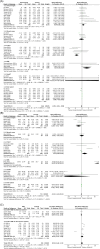Effectiveness of Mind-Body Exercise in Older Adults With Sarcopenia and Frailty: A Systematic Review and Meta-Analysis
- PMID: 40254030
- PMCID: PMC12009637
- DOI: 10.1002/jcsm.13806
Effectiveness of Mind-Body Exercise in Older Adults With Sarcopenia and Frailty: A Systematic Review and Meta-Analysis
Erratum in
-
Correction to "Effectiveness of Mind-Body Exercise in Older Adults With Sarcopenia and Frailty: A Systematic Review and Meta-Analysis".J Cachexia Sarcopenia Muscle. 2025 Aug;16(4):e13875. doi: 10.1002/jcsm.13875. J Cachexia Sarcopenia Muscle. 2025. PMID: 40631506 Free PMC article. No abstract available.
Abstract
Background: Mind-body exercise (MBE) has shown promise in mitigating the effects of sarcopenia and frailty in older adults. Nevertheless, its effectiveness in enhancing muscle function and physical performance in this population has not been well established. This study aimed to investigate the effects of MBE on older adults with sarcopenia and frailty, to offer evidence-based exercise recommendations.
Methods: A comprehensive search for randomized controlled trials (RCTs) was conducted through multiple databases, including PubMed, Embase, Cochrane Library, Web of Science, PsycINFO, CINAHL, China National Knowledge Infrastructure (CNKI), WanFang, and Chinese Scientific Journals Full-Text Database (VIP), supplemented by manual reference searches from inception until February 2024. The eligible RCTs compared MBE with passive or active exercise controls, focusing on muscle function and physical performance in older adults aged 60 years or above. Subgroup analyses were conducted to evaluate the types, duration, and frequency of MBE.
Results: Nine eligible RCTs with 1838 participants were included in this study. MBE demonstrated significant improvements compared with passive control, particularly in grip strength (WMD [weighted mean difference] = 0.99; 95% CI [95% confidence interval] = 0.06, 1.92; I2 = 3%, p = 0.04), Timed Up and Go Test (TUGT) (WMD = -4.04; 95% CI = -5.54, -2.53; I2 = 12%, p < 0.01), and Berg Balance Scale (BBS) scores (WMD = 3.63; 95% CI = 0.38, 6.87; I2 = 0%, p = 0.03). Even when compared to active exercise training, improvements were still observed in TUGT and BBS (p < 0.001), with a trend toward improved grip strength (WMD = -2.20; 95% CI = -4.35, -0.04; p = 0.05). No positive effect on muscle mass was observed. Subgroup analysis indicated that MBE performed more than 5 times a week for a short or medium duration (4-24 weeks) could improve grip strength (p < 0.05). Moderate-frequency intervention over a short period in this population yielded greater improvements in gait speed and Chair Rise Test completion time (p < 0.05).
Conclusions: MBE can enhance muscle function and physical performance to some extent in older adults with sarcopenia and frailty, whether they are compared with passive or active exercise training. However, positive effects on muscle mass have not been observed. Future studies are warranted to compare it with well-designed active exercise training programs that match the exercise volume, to draw more definitive conclusions to support the notion that MBE yields comparable effects.
Keywords: meta‐analysis; mind–body exercise; older adults; sarcopenia and frailty.
© 2025 The Author(s). Journal of Cachexia, Sarcopenia and Muscle published by Wiley Periodicals LLC.
Conflict of interest statement
The authors declare no conflicts of interest.
Figures




References
Publication types
MeSH terms
Grants and funding
- KFKT-2022-012/Scientific Research Project of Chinese Association of Rehabilitation Medicine
- XQC2023005/Scientific Research Foundation for the Top Youth Talents of Fujian University of Traditional Chinese Medicine
- X2023006/Fujian University of Traditional Chinese Medicine Research Fund
- 2023YFC3503701/The Key Research and Development project funded by the Ministry of Science and Technology of the People's Republic of China
LinkOut - more resources
Full Text Sources

